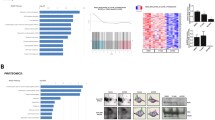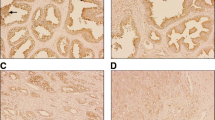Abstract
Prostate cancer (PCa) has high mortality rates, with most of the deaths resulting from the development of metastasis. Fibronectin (FN) plays key roles in cell adhesion and affects the migratory behavior of cells. In the tumor microenvironment and also in the blood plasma during metastasis, FN displays increased expression, however its role in prostate cancer remains poorly understood. This study aimed to unveil the specific roles of FN as a soluble component, alone or in combination with a complex basement membrane. To investigate the impact of FN in neoplastic prostate cells, we evaluated the gene expression of LNCaP cells by RT-qPCR after exposure to soluble FN (25 µg/mL) either alone or in combination with a basement membrane. When FN was the predominant matrix element, such as in blood plasma, PCa tumor cells increased their expression of genes related to an invasive behavior and resistance to apoptosis, including CDH2, ITGA5, AKT1, and BCL2. However, the combined presence of FN and a complex basement membrane had the opposite effect on LNCaP cells, in which the expression levels of CDH2, ITGA5, AKT1, and BCL2 were reduced. Hierarchical clustering analysis with LNCaP and RWPE-1 cells showed that LNCaP cells exposed to an enriched extracellular matrix displayed an expression pattern more similar to that shown by RWPE-1 cells, a cell line that illustrates characteristics of the normal prostate epithelium. These findings provide the groundwork for future studies addressing the role of FN in tumor growth, particularly in the context of cancer evolution/progression from a solid primary tumor to a transitory circulating state.




Similar content being viewed by others
References
Torre LA, Bray F, Siegel RL, Ferlay J, Lortet-Tieulent J, Jemal A (2015) Global cancer statistics, 2012. CA Cancer J Clin 65:87–108
Welch HG, Albertsen PC (2009) Prostate cancer diagnosis and treatment after the introduction of prostate-specific antigen screening: 1986–2005. J Natl Cancer Inst 101:1325–1329
Brower V (2007) Researchers tackle metastasis, cancer’s last frontier. J Natl Cancer Inst 99:109–111
Palumbo A, Ferreira LB, Reis de Souza PAVV, Oliveira FL de, Pontes B, Viana NB et al (2012) Extracellular matrix secreted by reactive stroma is a main inducer of pro-tumorigenic features on LNCaP prostate cancer cells. Cancer Lett 321:55–64
Liotta LA, Kohn EC (2001) The microenvironment of the tumour-host interface. Nature 411:375–379
Cooper CR, Chay CH, Gendernalik JD, Lee H-L, Bhatia J, Taichman RS et al (2003) Stromal factors involved in prostate carcinoma metastasis to bone. Cancer 97:739–747
Quail DF, Joyce JA (2013) Microenvironmental regulation of tumor progression and metastasis. Nat Med 19:1423–1437
Jung H-Y, Fattet L, Yang J (2015) Molecular pathways: linking tumor microenvironment to epithelial-mesenchymal transition in metastasis. Clin Cancer Res 21:962–968
Friedl P, Wolf K (2003) Tumour-cell invasion and migration: diversity and escape mechanisms. Nat Rev Cancer 3:362–374
Datta K, Muders M, Zhang H, Tindall DJ (2010) Mechanism of lymph node metastasis in prostate cancer. Future Oncol NIH Public Access 6:823–836
Ye L, Kynaston HG, Jiang WG (2007) Bone metastasis in prostate cancer: molecular and cellular mechanisms. Int J Mol Med 20:103–111
Malik G, Knowles LM, Dhir R, Xu S, Yang S, Ruoslahti E et al (2010) Plasma fibronectin promotes lung metastasis by contributions to fibrin clots and tumor cell invasion. Cancer Res 70:4327–4334
Palumbo JS, Talmage KE, Massari JV, La Jeunesse CM, Flick MJ, Kombrinck KW et al (2005) Platelets and fibrinogen increase metastatic potential by impeding natural killer cell-mediated elimination of tumor cells. Blood 105:178–185
Im JH, Fu W, Wang H, Bhatia SK, Hammer DA, Kowalska MA et al (2004) Coagulation facilitates tumor cell spreading in the pulmonary vasculature during early metastatic colony formation. Cancer Res 64:8613–8619
Giancotti FG, Ruoslahti E (1999) Integrin signaling. Science 285:1028–1032
Stathakis NE, Fountas A, Tsianos E (1981) Plasma fibronectin in normal subjects and in various disease states. J Clin Pathol 34:504–508
Pankov R, Yamada KM (2002) Fibronectin at a glance. J Cell Sci 115:3861–3863
Zhang X, Liu S, Hu T, Liu S, He Y, Sun S (2009) Up-regulated microRNA-143 transcribed by nuclear factor kappa B enhances hepatocarcinoma metastasis by repressing fibronectin expression. Hepatology 50:490–499
Kaspar M, Zardi L, Neri D (2006) Fibronectin as target for tumor therapy. Int J Cancer 118:1331–1339
Barilla ML, Carsons SE (2000) Fibronectin fragments and their role in inflammatory arthritis. Semin Arthritis Rheum 29:252–265
Janković MM, Kosanović MM (2008) Fibronectin pattern in benign hyperplasia and cancer of the prostate. Dis Markers 25:49–58
Horoszewicz JS, Leong SS, Kawinski E, Karr JP, Rosenthal H, Chu TM et al (1983) LNCaP model of human prostatic carcinoma. Cancer Res 43:1809–1818
Moroz A, Delella FK, Lacorte LM, Deffune E, Felisbino SL (2013) Fibronectin induces MMP2 expression in human prostate cancer cells. Biochem Biophys Res Commun 430:1319–1321
Schroeder A, Mueller O, Stocker S, Salowsky R, Leiber M, Gassmann M et al (2006) The RIN: an RNA integrity number for assigning integrity values to RNA measurements. BMC Mol Biol 7:3
Livak KJ, Schmittgen TD (2001) Analysis of relative gene expression data using real-time quantitative PCR and the 2 − ΔΔC t method. Methods 25:402–408
Riedl SJ, Salvesen GS (2007) The apoptosome: signalling platform of cell death. Nat Rev Mol Cell Biol 8:405–413
Zhu ML, Kyprianou N (2010) Role of androgens and the androgen receptor in epithelial-mesenchymal transition and invasion of prostate cancer cells. FASEB J 24:769–777
Strohmeyer N, Bharadwaj M, Costell M, Fässler R, Müller DJ (2017) Fibronectin-bound α5β1 integrins sense load and signal to reinforce adhesion in less than a second. Nat Mater 16:1262–1270
Cavallaro U, Christofori G (2004) Cell adhesion and signalling by cadherins and Ig-CAMs in cancer. Nat Rev Cancer 4:118–132
Matter ML, Ruoslahti E (2001) A signaling pathway from the alpha5beta1 and alpha (v) beta3 integrins that elevates bcl-2 transcription. J Biol Chem 276:27757–27763
Manning BD, Toker A (2017) AKT/PKB signaling: navigating the network. Cell 169:381–405
Kale J, Osterlund EJ, Andrews DW (2018) BCL-2 family proteins: changing partners in the dance towards death. Cell Death Differ 25:65–80
Frantz C, Stewart KM, Weaver VM (2010) The extracellular matrix at a glance. J Cell Sci 123:4195–4200
Glentis A, Oertle P, Mariani P, Chikina A, El Marjou F, Attieh Y et al (2017) Cancer-associated fibroblasts induce metalloprotease-independent cancer cell invasion of the basement membrane. Nat Commun 8:924
Bissell MJ, Hines WC (2011) Why don’t we get more cancer? A proposed role of the microenvironment in restraining cancer progression. Nat Med 17:320–329
Ruoslahti E (1984) Fibronectin in cell adhesion and invasion. Cancer Metastasis Rev 3:43–51
Steel DM, Harris H (1989) The effect of antisense RNA to fibronectin on the malignancy of hybrids between melanoma cells and normal fibroblasts. J Cell Sci 93(Pt 3):515–524
Jia D, Entersz I, Butler C, Foty RA (2012) Fibronectin matrix-mediated cohesion suppresses invasion of prostate cancer cells. BMC Cancer 12:94
Pentyala SN, Whyard TC, Waltzer WC, Meek AG, Hod Y (1998) Androgen induction of urokinase gene expression in LNCaP cells is dependent on their interaction with the extracellular matrix. Cancer Lett 130:121–126
Fornaro M, Plescia J, Chheang S, Tallini G, Zhu Y-M, King M et al (2003) Fibronectin protects prostate cancer cells from tumor necrosis factor-alpha-induced apoptosis via the AKT/survivin pathway. J Biol Chem 278:50402–50411
Von Au A, Vasel M, Kraft S, Sens C, Hackl N, Marx A et al (2013) Circulating fibronectin controls tumor growth. Neoplasia Neoplasia Press 15:925–938
Knowles LM, Malik G, Pilch J (2013) Plasma fibronectin promotes tumor cell survival and invasion through regulation of Tie2. J Cancer 4:383–390
Jennbacken K, Tesan T, Wang W, Gustavsson H, Damber J-E, Welén K (2010) N-cadherin increases after androgen deprivation and is associated with metastasis in prostate cancer. Endocr Relat Cancer 17:469–479
Chen X, Sievers E, Hou Y, Park R, Tohme M, Bart R et al (2005) Integrin alpha v beta 3-targeted imaging of lung cancer. Neoplasia 7:271–279
Schneider JG, Amend SR, Weilbaecher KN (2011) Integrins and bone metastasis: integrating tumor cell and stromal cell interactions. Bone 48:54–65
Morgan S, Gower (2000) Fibronectin influences cellular proliferation and apoptosis similarly in LNCaP and PC-3 prostate cancer cell lines. Urol Oncol 5:155–159
Scott G, Cassidy L, Busacco A (1997) Fibronectin suppresses apoptosis in normal human melanocytes through an integrin-dependent mechanism. J Investig Dermatol 108:147–153
Pullan S, Wilson J, Metcalfe A, Edwards GM, Goberdhan N, Tilly J et al (1996) Requirement of basement membrane for the suppression of programmed cell death in mammary epithelium. J Cell Sci 109:631–642
Bernard D, Pourtier-Manzanedo A, Gil J, Beach DH (2003) Myc confers androgen-independent prostate cancer cell growth. J Clin Investig 112:1724–1731
Asadi FK, Sharifi R (1995) Effects of sex steroids on cell growth and C-myc oncogene expression in LN-CaP and DU-145 prostatic carcinoma cell lines. Int Urol Nephrol 27:67–80
Umbas R, Isaacs WB, Bringuier PP, Schaafsma HE, Karthaus HF, Oosterhof GO et al (1994) Decreased E-cadherin expression is associated with poor prognosis in patients with prostate cancer. Cancer Res 54:3929–3933
Tomita K, van Bokhoven A, van Leenders GJ, Ruijter ET, Jansen CF, Bussemakers MJ et al (2000) Cadherin switching in human prostate cancer progression. Cancer Res 60:3650–3654
Yuan X-J, Whang YE (2002) PTEN sensitizes prostate cancer cells to death receptor-mediated and drug-induced apoptosis through a FADD-dependent pathway. Oncogene 21:319–327
Howlett AR, Petersen OW, Steeg PS, Bissell MJ (1994) A novel function for the nm23–H1 gene: overexpression in human breast carcinoma cells leads to the formation of basement membrane and growth arrest. J Natl Cancer Inst 86:1838–1844
Dubois C, Dufour R, Daumar P, Aubel C, Szczepaniak C, Blavignac C et al (2017) Development and cytotoxic response of two proliferative MDA-MB-231 and non-proliferative SUM1315 three-dimensional cell culture models of triple-negative basal-like breast cancer cell lines. Oncotarget 8:95316–95331
Kenny PA, Bissell MJ (2003) Tumor reversion: correction of malignant behavior by microenvironmental cues. Int J Cancer 107:688–695
Ramos G, de O, Bernardi, Lauxen L, Sant’Ana Filho I, Horwitz M, Lamers AR ML (2016) Fibronectin modulates cell adhesion and signaling to promote single cell migration of highly invasive oral squamous cell carcinoma. PLoS ONE 11:e0151338
Webber MM, Bello D, Quader S (1996) Immortalized and tumorigenic adult human prostatic epithelial cell lines: characteristics and applications. Part I. Cell markers and immortalized nontumorigenic cell lines. Prostate 29:386–394
Acknowledgements
This article comprises part of the Master dissertation of BM, supported by FAPESP (São Paulo Research Foundation) funding (#Grants 2014/25702-0 and 2013/26114-2).
Author information
Authors and Affiliations
Corresponding author
Ethics declarations
Conflict of interest
The authors have no conflicts of interest.
Electronic supplementary material
Below is the link to the electronic supplementary material.
Rights and permissions
About this article
Cite this article
Martinucci, B., Minatel, B.d., Cucielo, M.S. et al. Basement membrane extract attenuates the more malignant gene expression profile accentuated by fibronectin in prostate cancer cells. Mol Cell Biochem 451, 131–138 (2019). https://doi.org/10.1007/s11010-018-3399-4
Received:
Accepted:
Published:
Issue Date:
DOI: https://doi.org/10.1007/s11010-018-3399-4




